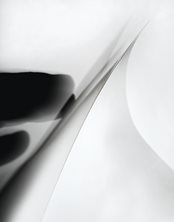



Feature Story
More feature stories by year:
2024
2023
2022
2021
2020
2019
2018
2017
2016
2015
2014
2013
2012
2011
2010
2009
2008
2007
2006
2005
2004
2003
2002
2001
2000
1999
1998
 Return to: 2016 Feature Stories
Return to: 2016 Feature Stories
CLIENT: CAMBRIOS
January/February, 2016: i3 It is Innovation
 You may not be familiar with silver nanowires but they are fast becoming essential in a wide array of consumer electronics (CE) products. They are being used in touchscreens, flexible displays, solar cells, OLED lighting, automotive and medical applications.
You may not be familiar with silver nanowires but they are fast becoming essential in a wide array of consumer electronics (CE) products. They are being used in touchscreens, flexible displays, solar cells, OLED lighting, automotive and medical applications.
You can't see them. You can't feel them. A silver nanowire is just a few nanometers in diameter and a few micrometers in length. These high (1,000:1) aspect ratio silver nanowires, when coated in a plastic substrate (typically PET), overlap to create a highly conductive, yet transparent network. The relatively sparse network of high aspect ratio silver nanowires allows light to pass through with exceptionally high transmission rates.
Developed and suspended in a fluid, the resulting "ink" is roll-to-roll coated in plastic film substrates. The ink, with suspended nanowires, is a mixture of highly conductive silver nanowires and other materials. Using this ink to cover a screen creates a touch surface that is transparent, highly responsive, thin and light. That makes them far more easily used in a wide variety of applications. So why is silver nanowire technology gaining significant market traction and adoption?
Transmission Brightness
At its core, silver nanowire technology does its job better than competing materials. High transmission (greater than 90 percent) along with low resistance (less than 30Ω/sq for touch applications; less than 10Ω/sq for other applications) enables 10-finger touch, a key component of a great user experience, particularly in laptops, all-in-one computers and other capacitive touchscreens. Higher transmission also improves battery life per-charge in mobile devices and creates brighter displays since the touch sensor doesn't impede light as much.
Cost-Effective Manufacturing
Silver nanowire trumps competing materials with lower capital equipment costs and reduced patterning costs. Single-layer touch sensors based on silver nanowires are less expensive than traditional materials because they use fewer layers of adhesives and substrates in the touchscreen stack—so less manufacturing complexity and materials consumed. The manufacturing itself uses room-temperature processing, equating to less power, requiring no consumables and no waste disposal issues. It's a greener way of making things.
 Flexibility
Flexibility
Whatever the application, silver nanowires offer significant flexibility (the next trend in consumer product design), not only for wearables but also for thin, light solar panels that can wrap around buildings. Building spaces previously unusable for photovoltaic arrays can now be employed, radically improving buildings' capacity for meeting ever-more-stringent energy efficiency mandates.
In real-world tests, silver nanowire coated films withstand greater than 450,000 repeated turns around a 1mm bending radius, demonstrating a great fit in flexible, rollable electronic products. Traditional materials do not flex.
Displays no longer have to be flat or rigid. Curved and flexible are in. Most touchscreens also require high-quality transparent conductors to provide a rich user e xperience. These features will make today's tablet computers appear as dated as desktops and help push portable computing into new market niches and price points. Kiosks, gaming machines, point-of-sale devices, automobile displays and GPS systems are key categories ripe for adoption.
Silver is Globally Available
It's not a rare commodity or traditional as exotic materials.
Mass Production-Ready
Carbon nanotubes/buds, graphene and other competing materials are still in early stages and not ready for mass production in price sensitive applications. Millions of CE devices using silver nanowires have already been shipped.
Thinner/Lighter
Silver nanowires lend themselves well to flexible/thin substrates. This enables sleek devices. Slim industrial design is what consumers are seeking.
Great Visual Characteristics
The most advanced silver nanowire touchscreen products have less haze than any competitor. This enhances the user experience and allows premium products using silver nanowire technology to command tier one design status and product differentiation.
OLED Lighting Adoption
Applications in organic light-emitting diodes (OLED), whether on a car's dashboard or in the next CE device, can provide lighting that conforms to a curved surface. Since OLED lighting is area lighting (meaning that there is no point or line source for the light, but the light emits through the surface of the light panel) it's uniform and more aesthetically pleasing. These attributes are valuable in high-end electronic devices, home theaters, museums, hotel lobbies, retail store displays or auto instrument panels. OLEDs create a new take on the classic five-dial instrument cluster in the Porsche's recently shown Mission E electric sedan concept car. How's that for a high-end consumer product?
With a flexible, bendable OLED lighting system using silver nanowires, three-dimensional lighting systems produce color-tunable light on any surface.
Market Traction Exists
Silver nanowires in touchscreens, solar cells and OLED lighting products are in production. It's not a matter of if it will be used; it's already being adopted across the globe by dozens of companies.
Easier to Make
Because of its lower complexity, companies manufacturing with silver nanowire include Okura, Hitachi, LG, 3M, Shinwa, Samsung, TPK, UDI, Touchworks, CNI with end customers including Lenovo, Karbonn, NEC, Advan, DELL, HP and Toshiba.
For high volume consumer and industrial applications, including large-area touchscreens, as well as miniature, flexible wearable displays, OLED lighting and PV solar panels, silver nanowires offer significant advantages both in cost and performance. Roll-to-roll processed silver nanowire transparent conductors are the clear choice for new production facilities needing high throughput and easy processing. They're also on target for CE OEMs needing a thin, light, bright, flexible material delivering high performance for their next killer products.
Sri Peruvemba is a vice president at Cambrios Technologies Corp. Cambrios provides innovative solutions using nanotechnology.
Return to: 2016 Feature Stories